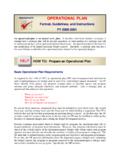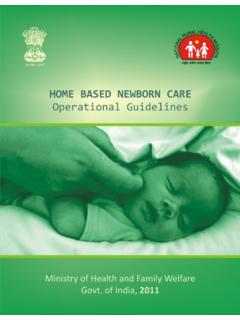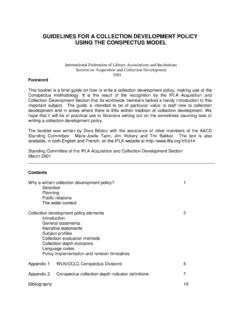Transcription of AVIAN PROTECTION PLAN (APP) GUIDELINES
1 AVIAN PROTECTION plan (APP) GUIDELINES A Joint Document Prepared By The Edison Electric Institute s AVIAN Power Line Interaction Committee (APLIC) and Fish and Wildlife Service (USFWS) April 2005 APP GUIDELINES The APP GUIDELINES presented in this document are intended to serve as a tool box from which a utility can select and tailor components applicable to its specific needs. These GUIDELINES are intended to be used in conjunction with APLIC s Suggested Practices for Raptor PROTECTION on Power Lines: The State of the Art in 1996 and Mitigating Bird Collisions with Power Lines: The State of the Art in 1994, or the most current editions of these documents, which contain more detail on construction design standards and line siting recommendations. These GUIDELINES are being distributed electronically.
2 While the introductory pages of the document are printed, the remainder of this tool box is electronic. This is a dynamic document and will be periodically updated as new information and resources become available. Additional copies of the APP GUIDELINES and current information on related issues can be downloaded from the AVIAN Power Line Interaction Committee (APLIC) ( ) and Edison Electric Institute (EEI) ( ) websites. In addition, the Suggested Practices for Raptor PROTECTION on Power Lines and Mitigating Bird Collisions with Power Lines manuals can be obtained from APLIC or EEI. Editor s note: Although this draft is being distributed in paper format, the final version will be distributed electronically as described above. ii APP GUIDELINES TABLE OF CONTENTS I.
3 Introduction 1 II. Background 7 III. Applicable Regulations 13 IV. APP Principles 16 Corporate Policy 17 Training 20 Permit Compliance 27 Construction Design Standards 30 Nest Management 43 AVIAN Reporting System 46 Risk Assessment Methodology 54 Mortality Reduction Measures 59 AVIAN Enhancement Options 62 Quality Control 64 Public Awareness 65 Key Resources 66 V. List of Acronyms 84iii APP GUIDELINES I. INTRODUCTION Since the formation of the AVIAN Power Line Interaction Committee (APLIC) in 1989, the electric utility industry and the Fish and Wildlife Service (USFWS) have worked together to reduce AVIAN electrocution and collision mortality. This has resulted in the cooperative development of GUIDELINES for AVIAN PROTECTION Plans (APP) by APLIC and USFWS, representing another milestone in AVIAN conservation.
4 The principles presented in these voluntary GUIDELINES are intended to allow utilities to tailor an APP that will best fit their needs while furthering the conservation of AVIAN species and improving reliability and customer service. A utility that implements the principles contained in these APP GUIDELINES will greatly reduce AVIAN risk as well its own risk of enforcement under the Migratory Bird Treaty Act (MBTA). Development and implementation of an APP makes good business sense because animal- and bird-caused outages are costly. A utility that creates an APP following these GUIDELINES and that addresses their specific AVIAN issues can benefit through regulatory compliance, reliability improvements, cost savings and positive recognition from regulators and customers. What is an AVIAN PROTECTION plan ? An AVIAN PROTECTION plan is a utility-specific document that delineates a program designed to reduce the operational and AVIAN risks that result from AVIAN interactions with electric utility facilities.
5 Although each utility s APP will be different, the overall goal of any APP should be to reduce AVIAN mortality. This document provides guiding principles and examples to aid utilities in their development of an APP. Although not all of these elements need to be included in every APP because of the specific circumstances of a utility or geographical area, they represent an overview of elements that should be considered for inclusion in an APP and that individual utilities may find helpful in crafting their own, individually-tailored APPs. 1 APP GUIDELINES Principles of an AVIAN PROTECTION plan 1. Corporate Policy An APP typically includes a statement of company policy confirming the company s commitment to work cooperatively towards the PROTECTION of migratory birds. This may include a commitment by the company to balance its goal of providing reliable electrical service in a cost-effective manner with the regulatory requirements protecting AVIAN species, as well as the need to obtain and comply with all necessary permits, monitor incidents of AVIAN mortality, and make reasonable efforts to construct and alter infrastructure to reduce the incidence of AVIAN mortality.
6 2. Training Training is an important element of an APP. All appropriate utility personnel, including managers, supervisors, line crews, engineering, dispatch, and design personnel, should be properly trained in AVIAN issues. This training should encompass the reasons, need, and method by which employees should report an AVIAN mortality, follow nest management protocols, dispose of carcasses, and comply with applicable regulations, including the consequences of non-compliance. Supplemental training also may be appropriate where there are material changes in regulations, permit conditions, or internal policies. APLIC-sponsored short courses on AVIAN electrocution, collision, and nest issues are conducted annually throughout the In addition, a two-hour overview presentation of AVIAN issues that can be used for internal company training is available from APLIC (see ).
7 3. Permit Compliance An APP can identify the process under which a company obtains and complies with all necessary permits related to AVIAN issues. Particular attention should be given to specific activities that can require take permits including, but not limited 2 APP GUIDELINES to, nest relocation, temporary possession, depredation, salvage/disposal, and scientific collection. 4. Construction Design Standards AVIAN interactions with facilities can cause outages or system reliability issues. To improve system reliability, AVIAN interactions should be considered in the design and installation of new facilities, as well as the operation and maintenance of existing facilities. For those reasons, inclusion of accepted construction standards for both new and retrofit techniques also should be included in an APP. Companies can either rely upon existing construction configurations recommended by APLIC (see Suggested Practices for Raptor PROTECTION on Power Lines: The State of the Art in 1996 and Mitigating Bird Collisions with Power Lines: The State of the Art in 1994, or the most current editions of these documents) or may choose to instead develop their own internal construction standards that meet or exceed these GUIDELINES .
8 These standards should be used in areas where new construction should be AVIAN -safe, as well as where existing infrastructure should be retrofitted to provide AVIAN safety. 5. Nest Management An APP may include procedures for nest management on utility structures. These procedures should be explained to company employees during training to ensure uniform treatment of AVIAN nest issues among personnel. 6. AVIAN Reporting System Although reporting of AVIAN mortalities may be required as a condition of Federal or State permits, a utility may also choose to voluntarily monitor relevant AVIAN interactions, including mortalities, through the development of an internal reporting system. An APP should consider providing for the development of such a reporting system, which can help a company pinpoint areas of concern by tracking both the specific locations where mortalities may be occurring, as well as 3 APP GUIDELINES the extent of such mortalities.
9 Data collected by company personnel can be limited to AVIAN mortalities or injuries, or could be expanded to include historical tracking of AVIAN nest problems, particularly problematic poles or line configurations, as well as remedial actions taken. All data should be regularly entered into a searchable database compatible for use in additional analysis (see Risk Assessment Methodology below). Bird Mortality Tracking System software developed by APLIC is available for free upon request at 7. Risk Assessment Methodology A utility can have the greatest impact on reducing AVIAN mortality by focusing its efforts in a cost-effective manner on the areas that pose the greatest risk to migratory birds. Therefore, as a general matter, an APP should include a method for evaluating the risks posed to migratory birds in a manner that identifies areas and issues of particular concern.
10 A risk assessment study will often begin with an assessment of available data addressing areas of high AVIAN use, AVIAN mortality, nesting problems, established flyways, adjacent wetlands, prey populations, perch availability, effectiveness of existing procedures, remedial actions and other factors that can increase AVIAN interactions with utility facilities. The AVIAN reporting system discussed in the previous section is an integral component of this risk assessment, as well as the use of AVIAN experts, birders, and biologists who can provide additional information on AVIAN distribution. An APP also may provide for the development of models that will enable a company to utilize biological and electrical design information to prioritize poles most in need of modifications, as well as research on the varied causes of AVIAN mortality and the benefits of utility structures to AVIAN species.






